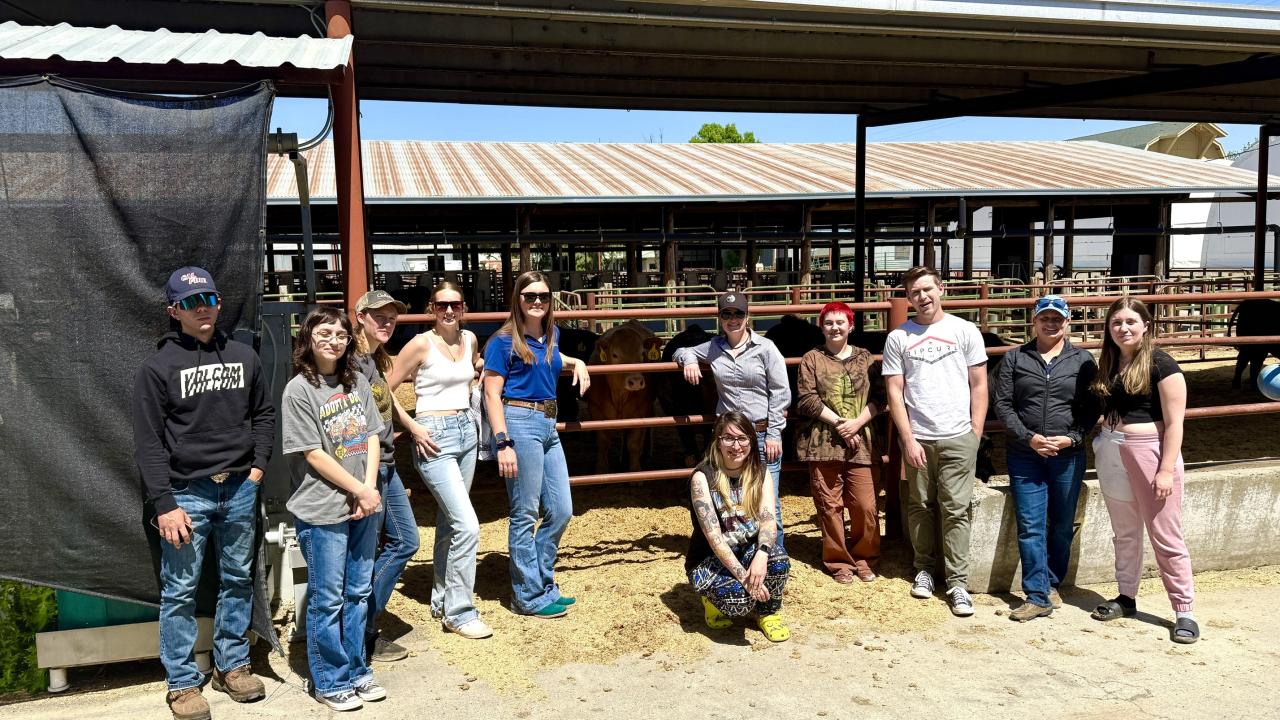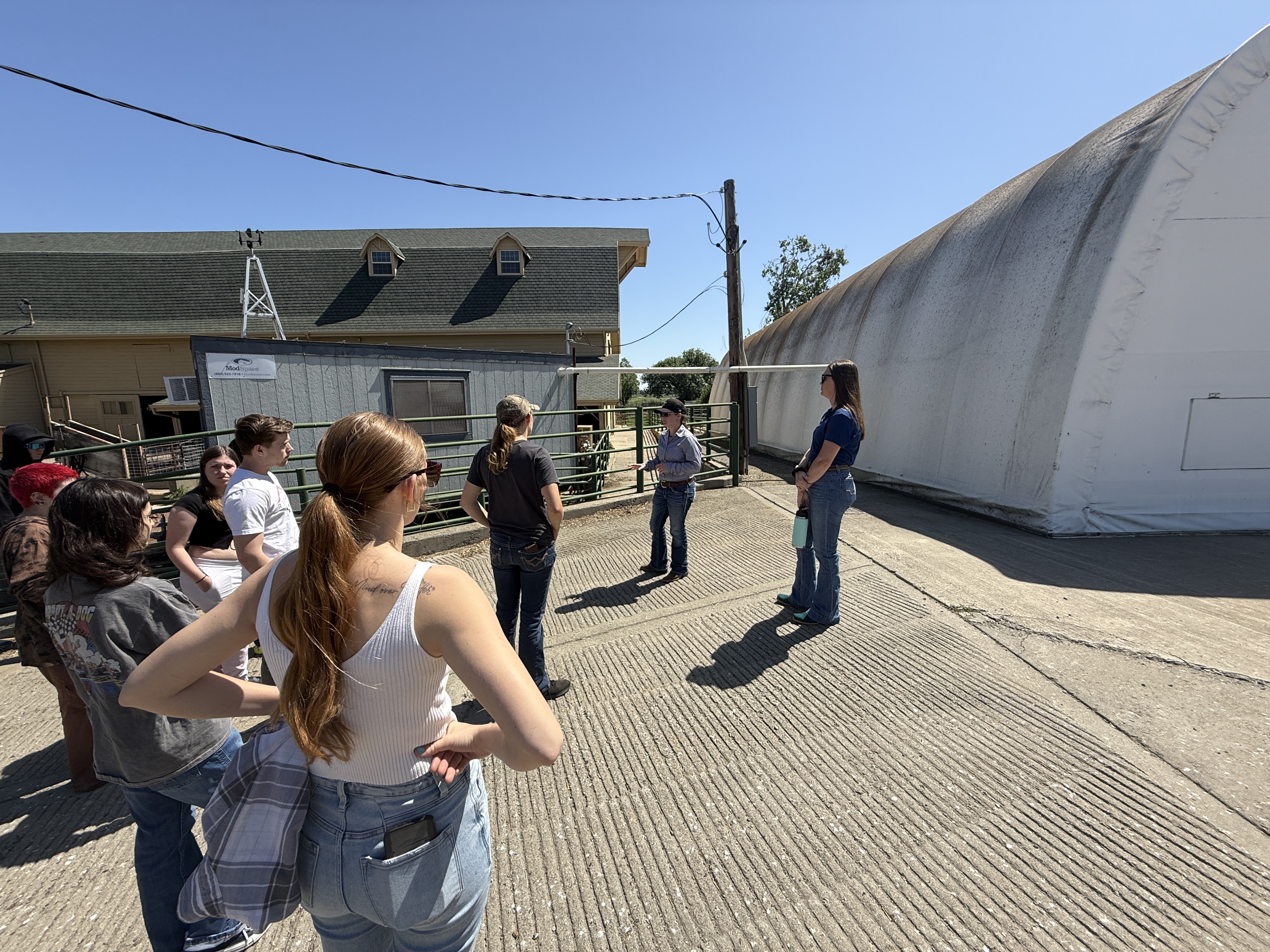
Learning Together: Sierra College Class Visits UC Davis CLEAR Center
As the saying goes, iron sharpens iron—and in that spirit, Ph.D. students from the CLEAR Center offered their expertise, guidance, and real-world insight to students visiting from a nearby community college.
Several students from the Animal Feeds and Nutrition course at Sierra College, recently visited the University of California, Davis feedlot to learn valuable educational and career knowledge from current UC Davis CLEAR Center students. The Sierra College course is taught by Elisa Noble, a UC Davis graduate with a degree in Agricultural and Environmental Technology and a minor in Animal Science. Having lived and worked at the UC Davis sheep barn, she knows firsthand the value of hands-on learning and the long-term impact it can have on students.

“All of the students in the class have taken an introductory class about Animal Science and this class is the next step in the course work. Most of the students have livestock experience and they want to be here and want to learn more,” said Noble. “And anytime you can make it more engaging and having them touch the animals and talk to their peers, they’re going to remember it more.”
CLEAR Center Ph.D. students Sharissa Anderson and Madison Kindberg led a tour of the UC Davis feedlot, where they empowered the class with foundational agricultural knowledge for future success and explained their ongoing research on reducing methane emissions in cattle.
Kindberg brought the students into the cattle pen enclosures and shared details about her research on early-life intervention feed additives and beef-on-dairy cattle. She explained that her work focuses on reducing methane emissions by introducing feed additives to calves during their first 90 days of life. The hope is that producers may be able to decrease cattle's long-term methane emissions by providing certain feed additives early in life. Along the way, Kindberg also offered advice on finding your own path in the agricultural world.
“Originally I was a vet med major and thought I wanted to do that but then I fell in love with the research side and knew this was the route I wanted to go,” Kindberg told the students. “It’s ok to change your mind and it’s ok to go towards what lights your soul on fire.”

Anderson then took the students over to the GreenFeed Machine which is utilized to capture individual enteric methane emissions from cattle. She spoke about her research with feed additives that could reduce methane in cattle. She further explained beef cattle nutrition and management and enteric mitigation strategies to reduce greenhouse gas production and to improve performance and efficiency of beef cattle. She also discussed how researchers at the CLEAR Center use a sampling method to measure cattle emissions over a 24-hour period. This sparked a broader conversation about careers in animal agriculture—highlighting that while it’s not your typical 9-to-5 job, it does offer meaningful, hands-on work that can be incredibly rewarding.
“Honestly my favorite part is the opportunity to share what I’m passionate about and what it is that I’m doing and why I’m doing it,” Anderson said of having the group out to the feedlot to learn about her research. “And having people come out here and get first-hand experience to see what we’re doing and why we’re doing it, is important.”
By getting a deeper understanding of research that has real-world impact in the agriculture sector, Noble hopes that it will empower students to become more informed leaders in the industry.
“I like to have them go out and visit the farms and understand the current issues,” Noble said. “And with climate and it’s one of the main current issues in livestock and so we want to make sure that the students have a little bit of a background on that too and so having UC Davis so close and doing the leading research on climate and reducing methane emissions, it just makes sense to have them come here and learn.”
For Ella Strubule Nistor, a Natural Science and Sustainable Agriculture major at Sierra College who was recently accepted to UC Davis, the field trip offered a chance to deepen her understanding of problem-solving in agriculture. It’s knowledge she hopes to apply as she works to reinvent her family’s nearly century-old farm in Loomis.

“I love that it’s hands on. And the interaction between all of us—that we can ask a ton of questions of the grad student—I love how that there’s no judgement,” Struble Nistor said. “We all come from different backgrounds, but we all got here. And they make everything more accessible.”
The course at Sierra College focuses on the principles of nutrition; nutrient requirements of non-ruminant and ruminant animals; and formulating diets to meet these requirements. And so, by connecting what they’ve learned in the classroom and then relating it to real world activities and research on nutrition, students will be encouraged to think critically and make sense of the world around them.
“It’s really awesome to see them come up to you and ask follow up questions and them wanting to dive deep and seeing them engaged is rewarding,” said Kindberg “Because even if they don’t go into this sector of agriculture, they’ll leave knowing a little bit more what we do and why we do it.”
Bringing students to the university feedlot for on the ground insight gives students a direct connection to the source of their food and a clearer understanding of the challenges farmers and researchers face. The goal is for this experience to deepen their knowledge of agriculture, sustainability, and environmental stewardship—making it an invaluable learning opportunity for the Sierra College students. At the same time, CLEAR Center students also gained meaningful educational experiences by sharing their work and engaging with their peers.
“Having these groups out here is great because they get to learn but I also get to learn a little bit more about myself and how I can become a better communicator and educator too,” Anderson said.
She added that it’s, “part of your responsibility in an agricultural career to be able to communicate about it and to share the truth and reshape the narrative because there’s a lot of miscommunications out there about agriculture. And for these students to walk away with a deeper understanding of animal agriculture is important, because then they can go out and help us to communicate the truths about it.”
(Photos: Tracy Sellers/UC Davis)
